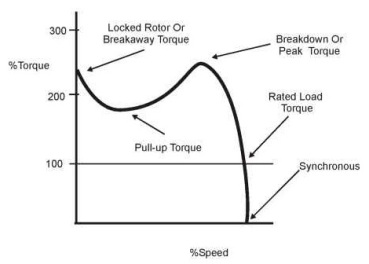When applying VARIABLE Frequency Drives(VFD), the speed-torque characteristics of an induction motor started at full voltage and operated on utility power is as follows.
Figure 1 shows the speed-torque curve for a 30HP, 1800 RPM induction motor in an application such as a conveyor where the load-torque requirement is constant from 0 RPM to approximately 1800 RPM.
When this motor is started across-the-line, the motor develops approximately 201% of full-load torque for starting and then accelerates along the speed-torque curve through the pull-up torque point, and finally operates near the full-load torque point, depending upon the actual load torque requirements.
If the load-torque requirement exceeds the maximum torque capability of the induction motor, the motor will not have enough torque to accelerate the load and will stall. For instance, if the load line required more torque than the motor could produce at the pull-up torque point (for example, 160% load torque versus 140% pull-up torque), the motor would not increase in speed past the pull-up torque speed and would not be able to accelerate the load. This would cause the motor to overheat, and/or overload devices to trip. It is, therefore, important to insure that the motor has adequate accelerating torque to reach full speed.
Normally, the motor accelerates the load and operates at the point of intersection of the load line and the motor speed-torque curve. The motor then always operates between the breakdown torque point and the synchronous speed point, which corresponds to the 1800 RPM location on the horizontal axis.
If additional load torque is required, the motor slows down or slips and develops more torque by moving up toward the breakdown torque point. Conversely, if less torque is required, the motor will speed up slightly toward the 1800 RPM point. Again, if the breakdown torque requirements are exceeded, the motor will stall.
It is easily understood by the following figure.
At any given speed, the motor would operate between the maximum torque point and the synchronous speed point. The amount of torque available would depend on the amount of current which could be supplied by the drive.

